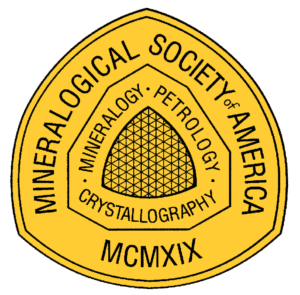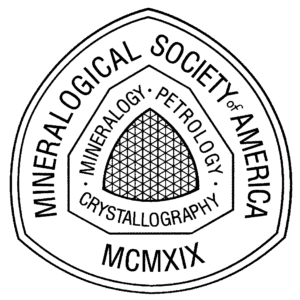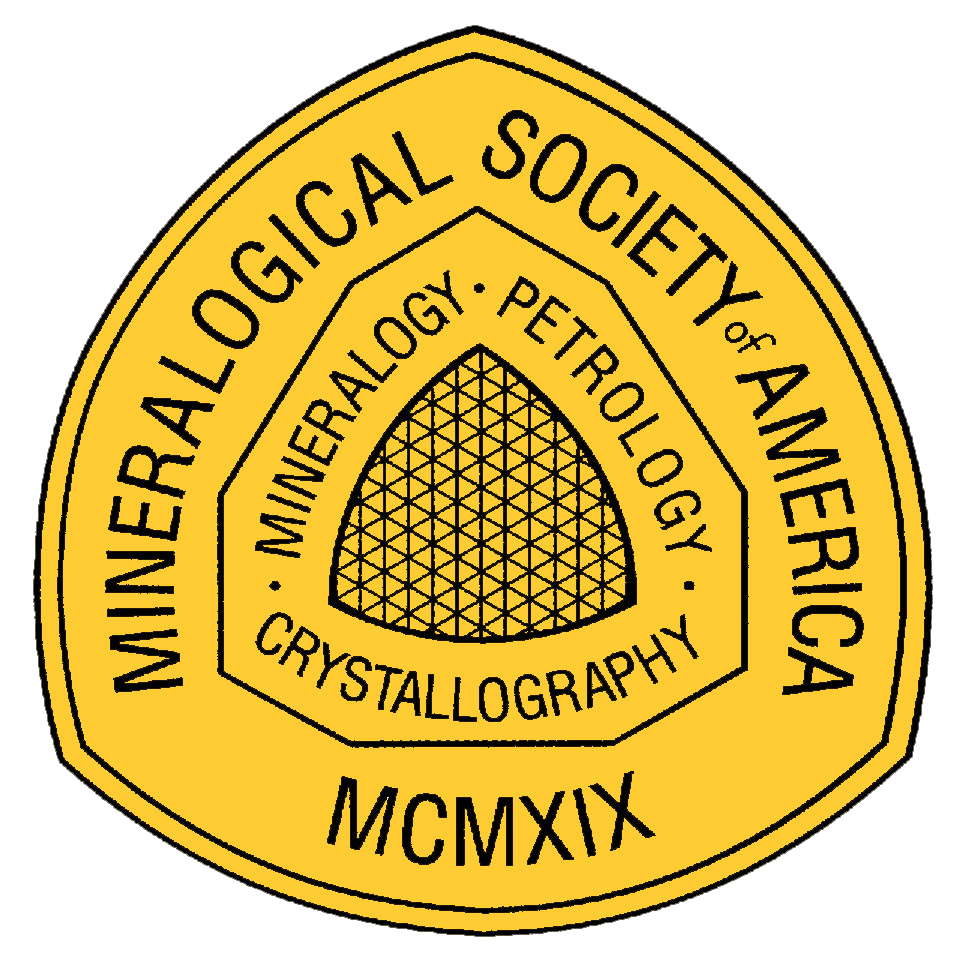
Editor’s Notes

Total Results: 1376
Volume 98 : April 2013 Issue
Redox systematics of martian magmas with implications for magnetite stability
https://doi.org/10.2138/am.2013.4251
On page 616 if this issue, Righter et al. show that Fe3+/Fe2+ ratios in high Fe martian basaltic rocks are much lower than the Fe3+/Fe2+ ratios in terrestrial samples that equilibrate at comparable fO2 conditions. This finding not only has implications for mineral stability, but impact, for example, mantle potential temperatures based on Fe-Mg partitioning in mantle derived liquids.
On the use of unpolarized infrared spectroscopy for quantitative analysis of absorbing species in birefringent crystals
https://doi.org/10.2138/am.2013.4316
On page 689 of this issue, Tony Withers presents a rigorous analysis of the use of unpolarized infrared (IR) spectra for the quantitative analysis of absorbing species. The Beer-Lambert law, which links IR absorbance to concentration of an absorbing species, cannot strictly be applied to unpolarized IR radiation in birefringent media. Polarized IR spectroscopy is often not possible, however, and using unpolarized IR in general introduces significant errors for strongly absorbing samples. Withers deduces a theory through which those errors can be avoided.
Nomenclature of the garnet supergroup
https://doi.org/10.2138/am.2013.4201
On page 785 of this issue, Grew et al. review the nomenclature of the garnet supergroup (which includes all minerals isostructural with garnet). The new nomenclature identifies 21 compositional end-members. Most of these are trace constituents, with only six comprising >20 mol% of any known mineral. Fans of hibschite, however, will be highly disappointed.
Volume 98 : February - March 2013 Issue
Microtexture development during rapid cooling in three rhyolitic lava flows
https://doi.org/10.2138/am.2013.4313
On page 304 of this issue, Seaman examines water contents of spherulites from three different rhyolite flows from southern Arizona. Water contents generally increase outward along the length of spherulite crystals. Water is not partitioned into the growing crystal structures, but is captured as fluid inclusions. Spherulites exhibit either blade-like or needle shapes, which vary as a function of cooling rate. Water contents also vary discontinuously along spherulite grains, and so likely monitor the build-up and occasional degassing of ambient melt.
Microbial and inorganic control on the composition of clay from volcanic glass alteration experiments
https://doi.org/10.2138/am.2013.4272
On page 319 of this issue, Cuadros et al. conduct experiments on volcanic glass to compare how clays are affected by fluid compositions and biogenic processes. Fluids as different as natural spring and hypersaline waters are reacted with basaltic glass. For the most part, clay compositions are controlled by glass compositions, not water chemistry. Geochemical relationships also show that clays nucleate within the glass, absorbing Al, Mg, and Fe form adjacent regions of glass, rather than being nucleated within neighboring fluids. Microbes, however, can affect clay compositions by trapping precursor glass in biofilms whereas more extreme fluid compositions may be trapped, and so affect clay composition.
High-pressure experiments on phase transition boundaries between corundum, Rh2O3(II)- and CaIrO3-type structures in Al2O3
https://doi.org/10.2138/am.2013.4133
"On page 335 of this issue, Kato et al. investigate phase transitions of Al2O3 at high pressures. Their work shows that the transition from a Rh2O3(II)-type to a CaIrO3-type structure occurs at ~170 GPa, i.e., pressures greater than the ~136 GPa that occur at the base of Earths mantle. Kato et al. thus reject the idea that subducted high-Al, anorthositelike compositions might be negatively buoyant in the lower mantle and so contribute mass to the D"" layer. The failure to reach the Rh2O3(II)-CaIrO3 phase transition instead means that Al2O3-phase-bearing materials will have a bulk density similar to ambient pyrolite in the lower mantle, and so would be advected upwards, rather than being stored at the core-mantle boundary."
Electronic structure effects in the vectorial bond-valence model
https://doi.org/10.2138/am.2013.4329
On page 340 of this issue, Bickmore et al. introduce an expansion of the vectorial bond-valence model (VBVM) and apply it to crystals of simple oxides. A key aspect of the VBVM is that the vector sum of bond valences incident to an ion should match some ideal value, similar to the way in which sums of electrostatic valence bond strengths are applied in Pauling's rules to test for stability. Bickmore et al. show that ideal vectorial valence sums can be predicted, even in cases where electronic structure effects such as lone pairs distort the coordination sphere, based on a quantity they call the minimum coordination number, which is the the absolute value of atomic valence divided by the valence of the strongest bond that reaches an ion. Crystals in which vectorial valence sums deviate strongly from ideal values tend to be unstable or metastable, so this model can be used to rationalize and predict phase stability.
Geometric analysis of radiation damage connectivity in zircon, and its implications for helium diffusion
https://doi.org/10.2138/am.2013.4249
On page 350 of this issue, Ketcham et al. report on a detailed study of alpha recoil tracks and fission tracks in zircon. Using the mathematics of percolation, they show that alpha recoil tracks percolate at doses two orders of magnitude lower than previously thought, i.e., at doses too small to be detected by swelling or metamictization, whereas fission tracks percolate near the dose levels required to see such effects. Perhaps counterintuitively, the percolation of alpha recoil tracks appears to minimize He diffusion, whereas the percolation of fission tracks is linked with poor He retention.
Eclogitic clasts with omphacite and pyrope-rich garnet in the NWA 801 CR2 chondrite
https://doi.org/10.2138/am.2013.4192
On page 387 of this issue, Kimura et al. report the first finding of a high-pressure mineral assemblage in clasts within a chondrite meteorite. Olivine is the dominant phase, but unlike other meteorites, it is accompanied by Na-Al-rich pyroxene (omphacite) and garnet, which also coexist with orthopyroxene and often phlogopite, a mineralogy that is akin, although not identical, to terrestrial eclogites. Subsolidus thermobarometers yield equilibration temperatures of 940-1080 C, and pressures of 2.8 to 4.2 GPa. These pressures are too low to represent shock conditions recorded in shock veins, and the pyrope-rich garnet and Na-Al-rich pyroxenes are hardly found in shocked meteorites in any case. A possible explanation is that these eclogite clasts formed in a planetary interior, although impact origin is not totally rejected. One possibility for the origin of these clasts is thus a parent body with a chondrite composition, and a minimum radius of 1500 km, larger than any existing asteroid. If this is the case, then the range of pressure for asteroid formation is considerably greater than previously considered.
Coexisting pseudobrookite, ilmenite, and titanomagnetite in hornblende andesite of the Coleman Pinnacle flow, Mount Baker, Washington: Evidence for a highly oxidized arc magma
https://doi.org/10.2138/am.2013.4185
On page 417 of this issue, Mullen and McCallum show evidence for very high oxygen fugacities for the Coleman Pinnacle andesite flow at Mt. Baker, Washington. The andesite contains an unusual assemblage of Fe-Ti-Mg oxides that includes pseudobrookite, a relatively rare mineral oxide, more commonly occurring in alkalic volcanic rocks. Their textural and mass balance considerations, and the high Mg no. of coexisting ilmenite-titanomagnetite pairs, suggest that pseudobrookite at Mt. Baker is not a low-temperature decomposition product, but rather the result of precipitation from a magma at very high fO2. Oxygen fugacities for the pseudobrookite-bearing samples are in the range of NNO+1.5 to NNO+1.75, whereas psuedobrookite-absent samples yield fugacities of NNO+0.75 to NNO+1.0. The pseudobrookite-bearing andesite has the highest abundance of fluid-mobile elements in Mt. Baker lavas and minimal crustal input. These features and the accompanying high water contents indicate that the high fO2 conditions are inherited from a hydrated mantle source.
Volume 98 : January 2013 Issue
Implications of equilibrium and disequilibrium among crystal phases in the Bishop Tuff
https://doi.org/10.2138/am.2013.4280
On page 271 of this issue, Evans and Bachmann (2013) re-evaluate published analyses of mineral compositions from the Bishop Tuff, but in contrast to prior studies, they apply a strikingly simple yet important tool for the assessment of equilibrium from metamorphic petrology: Roozeboom diagrams. These authors compare XMg (mole fraction of Mg in phase (small greek phi, your browser may vary)) for ilmenite, biotite, orthopyroxene, magnetite, and clinopyroxene. Invariant and wide-ranging XMg in the pyroxenes disallows their equilibrium with other crystalline phases, but monotonic trends in plots of XMgilm vs. XMg, with plausible (0, 0) and (1, 1) intercepts allow equilibrium between all other crystalline phases. Evans and Bachmann conclude that ilmenite-magnetite pairs faithfully record magma temperatures of a water saturated high SiO2 rhyolite magma, at ~700C, which later mixed with a hotter (~800C) recharge magma. This recharge event donated to the resident high SiO2 magma the (now disequilibrium) pyroxenes, and compatible elements such as Mg and Sr, and caused melting of resident sanidine, thereby contributing Ba and K to ambient (and mixed) high SiO2 melt. This work thus supports the recharge-partial melting model of Hildreth and Wilson (2007) and Wark et al. (2007), which explains some otherwise troublesome trace element systematics.
Correlating planar microstructures in shocked zircon from the Vredefort Dome at multiple scales: Crystallographic modeling, external and internal imaging, and EBSD structural analysis
https://doi.org/10.2138/am.2013.4165
On page 53 of this issue, Erickson et al. (2013) use microstructures in shocked detrital zircon grains to gauge the pressures of impact metamorphism and deformation history at the Vredefort Dome in South Africa, which at 2 Ga is the oldest impact site yet identified on Earth. Zircon samples are an especially useful target because they are able to survive impact, as well as later uplift, erosion, and sedimentary transport, allowing long-lasting preservation of impact effects. This work shows that impact pressures at Vredefort Dome are between 20 and 40 GPa, as planar fractures develop only above the lower of these pressures, while zircon converts to reidite (not observed in their shocked crystals) at the upper pressure limit.
Mineralogical characterization and formation of Fe-Si oxyhydroxide deposits from modern seafloor hydrothermal vents
https://doi.org/10.2138/am.2013.4147
On page 85 of this issue, Sun et al. (2013) examine inter-layered growths of Fe-Si oxides from hydrothermal vents within the Lau Basin. Their work shows that biogenic Fe hydroxides can easily bind to dissolve silica, leading to an intimate mixture of Fe-Si oxides. These Fe-Si oxides grow in two stages. The first involves the formation of minerals such as ferrihydrite, as bacteria oxidize Fe2+ to Fe3+ in the process of fixing dissolved CO2 from hydrothermal fluids. This initially loose network of ferrihydrite crystals becomes increasingly dense, to the point where hydrothermal fluids no longer freely circulate, which allows Si-supersaturated solutions within the structure to precipitate opal. The result is not a banded structure, but instead an intimate mixture of Fe-Si oxides, which implies that the separation of Fe- and Si-rich layers in banded iron formations occur by later, digenetic processes, rather than by direct biogenic-mediated precipitation of alternating Fe- and Si-rich layers.
Cathodoluminescence properties of quartz eyes from porphyry-type deposits: Implications for the origin of quartz
https://doi.org/10.2138/am.2013.4018
On page 98 of this issue, Vasyukova et al. (2013) investigate trace element zoning by cathodoluminescnece in quartz crystals from porphyritic, mineralized granitic rocks. Quartz crystals yield oscillatory zoning patterns for Ti, with sharp compositional boundaries relative to Ti, but gradational boundaries relative to Al contents. They also examined clusters of quartz crystals, where individual grains exhibit very different Ti contents. Several of their observations suggest that Ti variations are unlikely controlled by temperature (T): (1) calculated T estimates from Wark and Watson (2006) range from 791 to 889 C, which are considered too high for late stage porphyritic intrusions; (2) unreasonably high T variations -- as great as 140 C -- are required to explain oscillations in Ti; and (3) sharp Ti oscillation boundaries imply seemingly unlikely sharp variations in T, especially in a late stage, non-convecting magma. The authors conclude that fluid loss increases Ti activity in the residual melt, and that oscillations in Ti concentrations reflect fluid loss events, rather than a record of thermal history.
First-principles study on the high-pressure phase transition and elasticity of KAlSi3O8 hollandite
https://doi.org/10.2138/am.2013.4077
On page 207 of this issue, Kawai and Tsuchiya (2013) show from first-principles calculations that K-hollandite II (KAlSi3O8) replaces K-hollandite I at high pressures, as the stable K aluminosilicate. At mantle temperatures, K-hollandite II would be stable from near the top of the lower mantle (at 700 to 770 km) down to the core mantle boundary. In the event that continental materials (alkali feldspars), perhaps in the form of subducted sediments, can survive to be subducted to the lower mantle, the K-hollandite II phase could then provide a significant repository for K and other large ion lithophile elements. This work further shows that solid solution effects of K-hollandite II with Na-hollandite II have only a negligible effect on K-hollandite II stability and that Na-hollandite is a metastable phase at lower mantle pressures.
Zircon growth and recrystallization during progressive metamorphism, Barrovian zones, Scotland
https://doi.org/10.2138/am.2013.4240
On page 219 of this issue, Vorhies et al. (2013) conduct SIMS U-Pb depth profiles of zircons in metamorphic rocks from the type section of Barrovian metamorphism in Scotland. Metamorphic grade for their samples ranges from the chlorite to sillimanite + K-feldspar. They find that even at the highest grades of metamorphism, only the very outermost margins of zircon rims (<1 micrometer depth) have their ages reset by metamorphism. Zircon interiors thus mostly record pre-metamorphic histories (pre-470 Ma), where in this case zircon interiors yield age dates of mostly 600 to 2000 Ma. In the outermost (<1 micrometer) zones, a range of age dates are recovered that reveal a complex history of decompression melting, later intrusion of granitic rocks, volcanism, and mineralization, ranging from 470 to 250 Ma. Only those zircon rims formed in the sillimanite zone contained rims that would be wide enough (>20 micrometers) to yield peak metamorphism age dates by spot analyses.
« ‹ 1 … 67 68 69
American Mineralogist offers many special themed article collections virtually. Articles that fall within the Special collection are published exactly as any other paper. Special collection papers are identified by headings.

Access is free to the Articles in the American Mineralogist from 1916 to 1999. Articles published in 2000-Present are restricted to Subscribers and Members.
